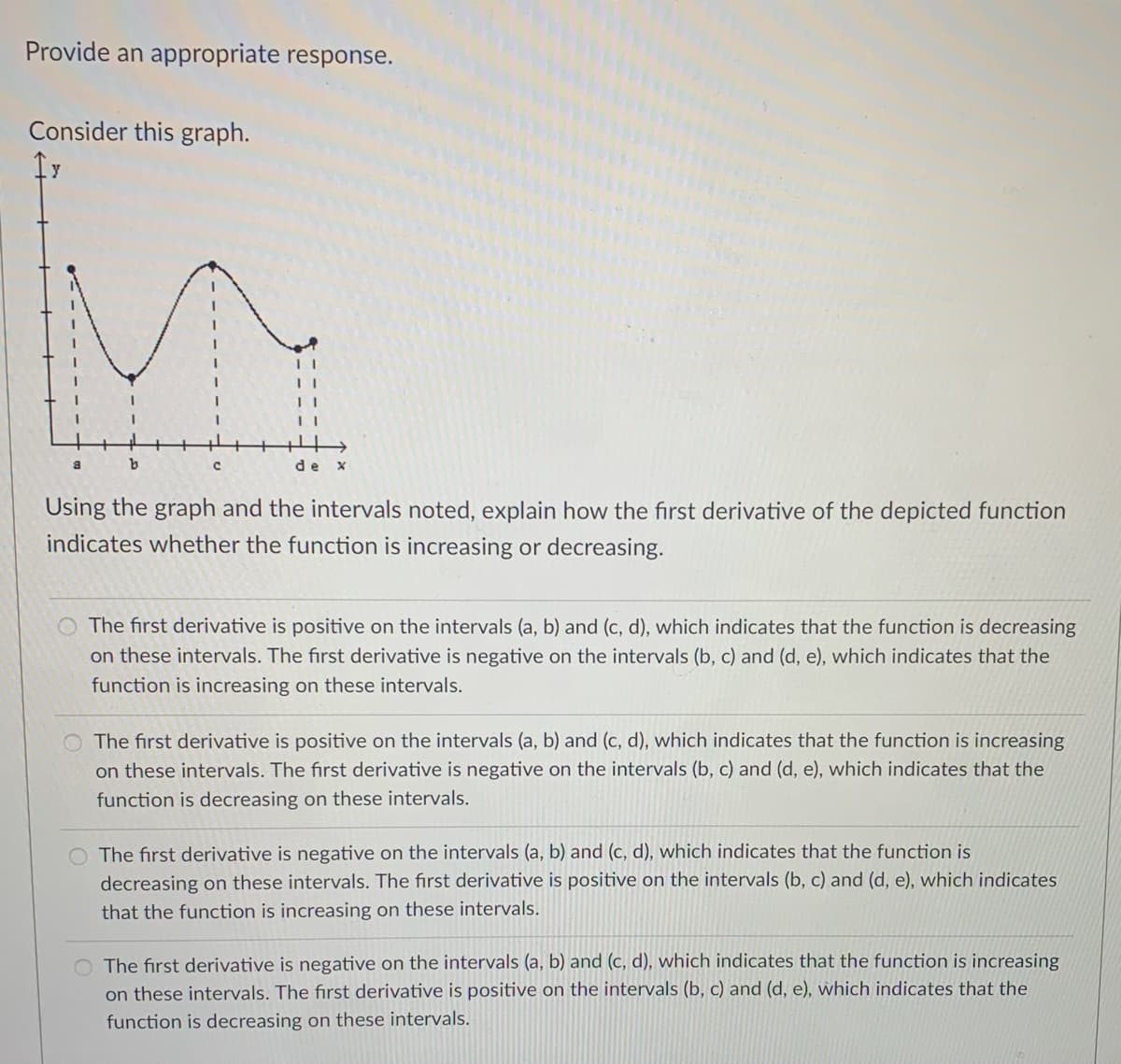Provide an appropriate response. Consider this graph. a b. de x Using the graph and the intervals noted, explain how the first derivative of the depicted function indicates whether the function is increasing or decreasing. O The first derivative is positive on the intervals (a, b) and (c, d), which indicates that the function is decreasing on these intervals. The first derivative is negative on the intervals (b, c) and (d, e), which indicates that the function is increasing on these intervals. The first derivative is positive on the intervals (a, b) and (c, d), which indicates that the function is increasing on these intervals. The first derivative is negative on the intervals (b, c) and (d, e), which indicates that the function is decreasing on these intervals. The first derivative is negative on the intervals (a, b) and (c, d), which indicates that the function is decreasing on these intervals. The first derivative is positive on the intervals (b, c) and (d, e), which indicates that the function is increasing on these intervals. O The first derivative is negative on the intervals (a, b) and (c, d), which indicates that the function is increasing on these intervals. The first derivative is positive on the intervals (b, c) and (d, e), which indicates that the function is decreasing on these intervals.
Provide an appropriate response. Consider this graph. a b. de x Using the graph and the intervals noted, explain how the first derivative of the depicted function indicates whether the function is increasing or decreasing. O The first derivative is positive on the intervals (a, b) and (c, d), which indicates that the function is decreasing on these intervals. The first derivative is negative on the intervals (b, c) and (d, e), which indicates that the function is increasing on these intervals. The first derivative is positive on the intervals (a, b) and (c, d), which indicates that the function is increasing on these intervals. The first derivative is negative on the intervals (b, c) and (d, e), which indicates that the function is decreasing on these intervals. The first derivative is negative on the intervals (a, b) and (c, d), which indicates that the function is decreasing on these intervals. The first derivative is positive on the intervals (b, c) and (d, e), which indicates that the function is increasing on these intervals. O The first derivative is negative on the intervals (a, b) and (c, d), which indicates that the function is increasing on these intervals. The first derivative is positive on the intervals (b, c) and (d, e), which indicates that the function is decreasing on these intervals.
Algebra & Trigonometry with Analytic Geometry
13th Edition
ISBN:9781133382119
Author:Swokowski
Publisher:Swokowski
Chapter5: Inverse, Exponential, And Logarithmic Functions
Section5.1: Inverse Functions
Problem 64E
Related questions
Question

Transcribed Image Text:Provide an appropriate response.
Consider this graph.
y
de x
Using the graph and the intervals noted, explain how the first derivative of the depicted function
indicates whether the function is increasing or decreasing.
The first derivative is positive on the intervals (a, b) and (c, d), which indicates that the function is decreasing
on these intervals. The first derivative is negative on the intervals (b, c) and (d, e), which indicates that the
function is increasing on these intervals.
The first derivative is positive on the intervals (a, b) and (c, d), which indicates that the function is increasing
on these intervals. The first derivative is negative on the intervals (b, c) and (d, e), which indicates that the
function is decreasing on these intervals.
O The first derivative is negative on the intervals (a, b) and (c, d), which indicates that the function is
decreasing on these intervals. The first derivative is positive on the intervals (b, c) and (d, e), which indicates
that the function is increasing on these intervals.
The first derivative is negative on the intervals (a, b) and (c, d), which indicates that the function is increasing
on these intervals. The first derivative is positive on the intervals (b, c) and (d, e), which indicates that the
function is decreasing on these intervals.
Expert Solution
This question has been solved!
Explore an expertly crafted, step-by-step solution for a thorough understanding of key concepts.
This is a popular solution!
Trending now
This is a popular solution!
Step by step
Solved in 2 steps

Recommended textbooks for you

Algebra & Trigonometry with Analytic Geometry
Algebra
ISBN:
9781133382119
Author:
Swokowski
Publisher:
Cengage

Big Ideas Math A Bridge To Success Algebra 1: Stu…
Algebra
ISBN:
9781680331141
Author:
HOUGHTON MIFFLIN HARCOURT
Publisher:
Houghton Mifflin Harcourt

Elementary Linear Algebra (MindTap Course List)
Algebra
ISBN:
9781305658004
Author:
Ron Larson
Publisher:
Cengage Learning

Algebra & Trigonometry with Analytic Geometry
Algebra
ISBN:
9781133382119
Author:
Swokowski
Publisher:
Cengage

Big Ideas Math A Bridge To Success Algebra 1: Stu…
Algebra
ISBN:
9781680331141
Author:
HOUGHTON MIFFLIN HARCOURT
Publisher:
Houghton Mifflin Harcourt

Elementary Linear Algebra (MindTap Course List)
Algebra
ISBN:
9781305658004
Author:
Ron Larson
Publisher:
Cengage Learning

College Algebra (MindTap Course List)
Algebra
ISBN:
9781305652231
Author:
R. David Gustafson, Jeff Hughes
Publisher:
Cengage Learning

College Algebra
Algebra
ISBN:
9781305115545
Author:
James Stewart, Lothar Redlin, Saleem Watson
Publisher:
Cengage Learning

Algebra and Trigonometry (MindTap Course List)
Algebra
ISBN:
9781305071742
Author:
James Stewart, Lothar Redlin, Saleem Watson
Publisher:
Cengage Learning